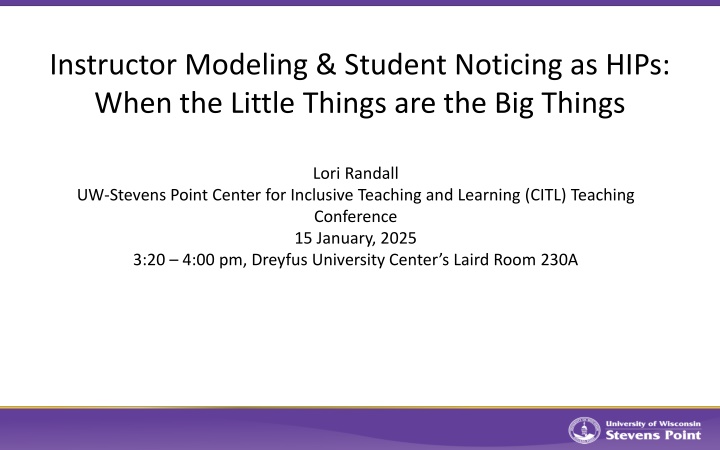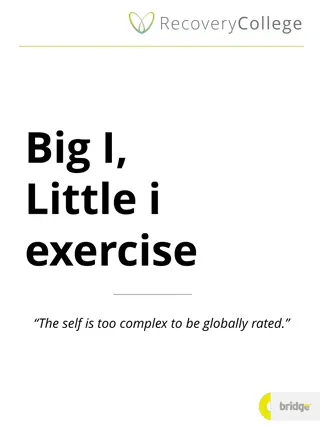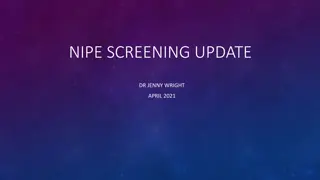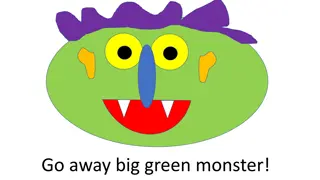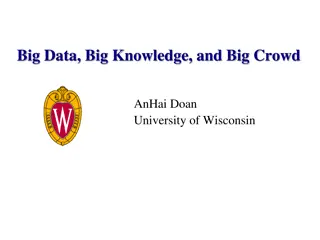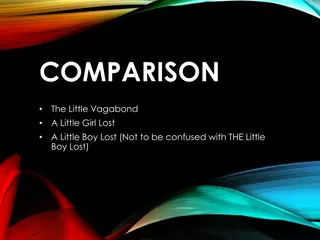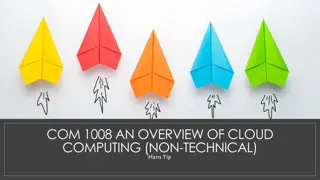Modeling & Student Noticing as HIPs: When the Little Things are the Big Things
Join Lori Randall from UW-Stevens Point CITL at the Teaching Conference to explore the impact of modeling and student noticing in higher education. Discover how paying attention to the little things can make a big difference in student learning and engagement.
Download Presentation

Please find below an Image/Link to download the presentation.
The content on the website is provided AS IS for your information and personal use only. It may not be sold, licensed, or shared on other websites without obtaining consent from the author.If you encounter any issues during the download, it is possible that the publisher has removed the file from their server.
You are allowed to download the files provided on this website for personal or commercial use, subject to the condition that they are used lawfully. All files are the property of their respective owners.
The content on the website is provided AS IS for your information and personal use only. It may not be sold, licensed, or shared on other websites without obtaining consent from the author.
E N D
Presentation Transcript
Instructor Modeling & Student Noticing as HIPs: When the Little Things are the Big Things Lori Randall UW-Stevens Point Center for Inclusive Teaching and Learning (CITL) Teaching Conference 15 January, 2025 3:20 4:00 pm, Dreyfus University Center s Laird Room 230A
Are you worried about finding time to incorporate HIPs into your teaching? Today, you ll discover how small, relatively simple strategies some of which may already feature in your teaching can meet the criteria of High-Impact Practices (HIPs).
The Time: Fall 2013 Semester The Place: The University of MI, Ann Arbor The Course: Writing 120 - Transition to College Writing for Multilingual Writers (2 sections) The Students: 38 from mainland China, 2 from France
The Problem: All but two students committed plagiarism on the first draft of their first assignment.
The Short-Term Solution: Sort things out one-by-one at students individual conferences with me.
The Long-Term Solution: On the first day of class in the Winter 2014 semester, review the university s academic integrity policy. Require students to complete a short Canvas quiz on the academic integrity policy.
The Time: Winter 2014 Semester The Place: The University of MI, Ann Arbor The Course: Writing 120 - Transition to College Writing for Multilingual Writers (1 section) The Students: 18 students from mainland China, 1 from Taiwan, 1 from Korea
The Problem: All students committed plagiarism on the first draft of their first assignment.
The Short-Term Solution: Sort things out one-by-one at students individual conferences with me.
The Long-Term Solution, Part One: During the first week of class in the Fall 2014 semester, engage students in conversation not just about the university s academic integrity policy but also about the concepts of intellectual property rights and academic integrity. Revisit/refer to this conversation frequently throughout the semester.
The Long-Term Solution, Part Two: Throughout the semester, provide reading guides that require students to notice when, how, and why the authors of the texts they read for our course incorporate others ideas into their own work. (Note that I was already in the habit of creating reading guides. Creating new reading guides or revising existing reading guides helped me review course readings, held students accountable for completing the readings, and helped students collect their thoughts before discussing the readings in class.) Supplement reading guides with a table of commonly used verbs that signal agreement, disagreement, partial agreement, etc. (Note that I did not need to create such a table, as our textbook provided one. Students and I added to or modified this table throughout the semester as we encountered new verbs or nuanced meanings of verbs that were already listed in the table.)
The Long-Term Solution, Part Three: Dedicate between 2 and 3 class sessions to an interactive lecture and whole-class discussion of (a) the way in-text citations and bibliographic entries work in western, English-language scholarly publications; and (b) differences between western, English-language scholarly citations/bibliographic entries and the citations/bibliographic entries found in scholarly works in students home countries. Revisit/refer to this lecture and conversation frequently throughout the semester.
The Long-Term Solution, Part Four: Spend one class period modeling my reading and note-taking strategy for students and providing opportunities for them to practice taking notes in a way that supports the acceptable use of others ideas. Refer to/revisit this conversation and activity as needed throughout the semester.
The Long-Term Solution, Part Five: Revise existing assignment criteria and prompts in ways that require or encourage students to explicitly apply the concepts they have learned/are learning about intellectual property rights; academic integrity; and western, English-language citation conventions.
How does this long-term solution meet the criteria of a HIP (high-impact practice)? 1) Performance levels are set appropriately high 2) Interactions with faculty and peers about substantive matters 3) Experiences with diversity (I sort of got a freebie on this one: diversity was inherently built into this class. These international students needed and expected to learn about the new cultural and linguistic norms of their host country and school.) 4) Frequent, timely, and constructive feedback 5) Periodic, structured opportunities to reflect and integrate learning 6) Opportunities to discover the relevance of learning through real-world applications
Why did it take me so long to devise a good solution to the problem? First, I was so focused on the challenges that I knew students faced using their second language 24/7 for both conversational and academic purposes that I failed to look for or notice other challenges that they might face. Second, the citation conventions of Western scholarly language and the concepts of academic integrity and intellectual property rights were so deeply ingrained in my own understanding of how and why to do academic writing that I failed to recognize how strange and unfamiliar these concepts were to my students. It never occurred to me that my students were trying to navigate American academic writing using a completely different philosophical and cultural map than the map I use.
What conventions, concepts, and knowledge are so deeply ingrained in your understanding of your discipline or your work as a scholar that you might not think about the need to actively teach them? Follow this link for a list of questions and observations to help you reflect on this question.
Time to reflect/write alone or with a partner or group. Time to share observations/ideas, if you are comfortable doing so.
Recommended Reading Caplan, N. A. (2019). Grammar Choices for Graduate and Professional Writers. University of Michigan Press. A practical handbook that supports writers in choosing the best language for their purposes by illustrating and explaining the relationships between language form and language function in published academic writing. Gee, J. P. (n.d.) Discourse, small-d, Big D. An introduction to the concept of Discourses (i.e., different language choices, behaviors, beliefs, and assumptions that must be learned when individuals join a new community of practice or add a new set of identity characteristics to the existing range of characteristics that signal their belonging in intersecting communities) Palmer, P. J. (1983). To Know as we are Known: Education as a Spiritual Journey. An unconventional, but thought-provoking, perspective on the relationship between the knower, the known, and the learning process. Schleppegrell, M. J. (2004). The Language of Schooling: A Functional Linguistics Perspective. Routledge. An overview of distinctive grammatical features and the epistemological and social beliefs they embody across the academic disciplines commonly taught in K-12 and post-secondary U.S. schools.
Loris contact info Lori Randall, Ph.D., Director of Student Retention and study skills course instructor, Wausau campus 323 CCC (Collins Classroom Center) 715-346-2484 lorandal@uwsp.edu
